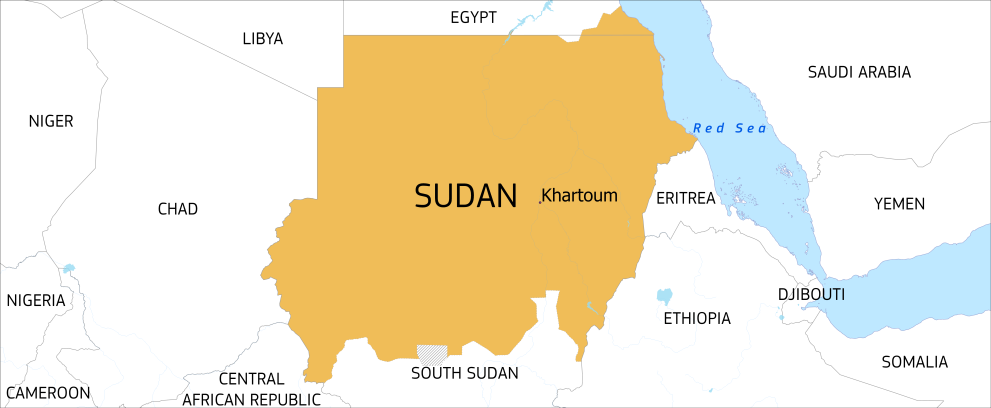Introduction
Violent armed clashes broke out in Khartoum on 15 April 2023 between the Sudanese Armed Forces (SAF) and the Rapid Support Forces (RSF). A year and a half into the conflict, it remains fluid and unpredictable. Warring parties are using heavy weapons in densely populated areas, with devastating consequences for civilians, with practices that may amount to war crimes. Food insecurity is catastrophic: famine was officially declared near the besieged town of El Fasher. Sudan is now the largest displacement crisis in the world.
What are the needs?
Around 25 million people (over half of Sudan’s inhabitants), of which 48% are children, urgently need humanitarian assistance in the country.
Violations of international human rights law and International Humanitarian Law by all parties to the conflict have been reported. As a result, a major protection crisis is unfolding. Save the Children estimates that about 18 million children in Sudan are out of school.
The food insecurity and nutrition situation is catastrophic. The latest Integrated Food Security Phase Classification (IPC) projection, released in June 2024, estimated that 25.6 million people would face a high level of acute food insecurity between June 2024 and September 2024, a 45% increase compared to October 2023 – February 2024. There is a risk of famine in 14 areas and famine in one IDP camp.
Throughout the country, 75% of health facilities in conflict-affected areas are considered out of service.
Shortages of food, clean water, medicines, cash, and fuel, along with limited communications and electricity, are being reported throughout the country.

The conflict has resulted in large waves of forced displacements, with over 13.2 million displaced people reported so far (17 September 2024). Out of these:
- over 10.9 million people are internally displaced,
- over 2.3 million people have fled outside Sudan.

How are we helping?
In 2024, the EU mobilised €147 million for the humanitarian response in Sudan. Together with the neighbouring countries, the EU has allocated €185 million to the Sudanese regional crisis.
At the 79th UN General Assembly in New York, President von der Leyen and Commissioner Lenarčič announced that an additional €69 million is requested for humanitarian assistance in Sudan and the neighbouring countries.
In 2023, the EU allocated over €128 million for the response to the humanitarian crisis in Sudan. The Commission’s total contribution to the response to the impact of the Sudan crisis in the neighbouring countries in 2023 was around €37 million.
Within the framework of the European Humanitarian Response Capacity (EHRC), the EU has completed 13 Humanitarian Air Bridge (HAB) flights to transport over 640 tonnes of assistance through Chad and Port Sudan in 2023. 2 flights are planned in 2024 to support the cross-border response from Chad to Sudan. The first flight will take place on 18 October from Liège to N’Djamena.
EU humanitarian aid provides communities with health and nutritional care, cash, food assistance, water and sanitation, shelter, protection, and education to the most vulnerable households – the internally displaced, refugee families, and host communities.
The EU also contributes to the nutritional treatment and care of children under 5 and pregnant or breastfeeding women across Sudan.
The EU continues to promote compliance with international humanitarian law for unhindered and safe access for humanitarian aid and the protection of civilians.
The safety and security of aid workers, premises, and assets in Sudan must be guaranteed so that they can provide emergency assistance to those affected, including via the following:
- waiving travel restrictions for humanitarian personnel and granting travel permits to move beyond Port Sudan,
- providing aid workers with immediate safe passage and guarantees for access and movement by road and air,
- fast-tracking visa applications to allow for the scaling up of humanitarian operations,
- easing customs restrictions to expedite imports of operational supplies,
- ensuring the safe movement of humanitarian staff and supplies without imposing armed escorts, which are putting their security, independence, and neutrality at risk.
Last updated: 18/11/2024
Facts & figures
24.8 million people in need of humanitarian assistance
25.6 million people projected to be in acute food insecurity (IPC phase 3 or above) between June and September 2024.
More than 8.11 million newly internally displaced since April 2023 and 2.35 million in cross-border displacement, as of 17 September 2024. It is estimated that in total there are at least 10.9 million internally displaced persons in Sudan, the highest number globally.
EU humanitarian funding in Sudan:
€147 million in 2024
Over €128 million in 2023
Almost €800 million since 2013

